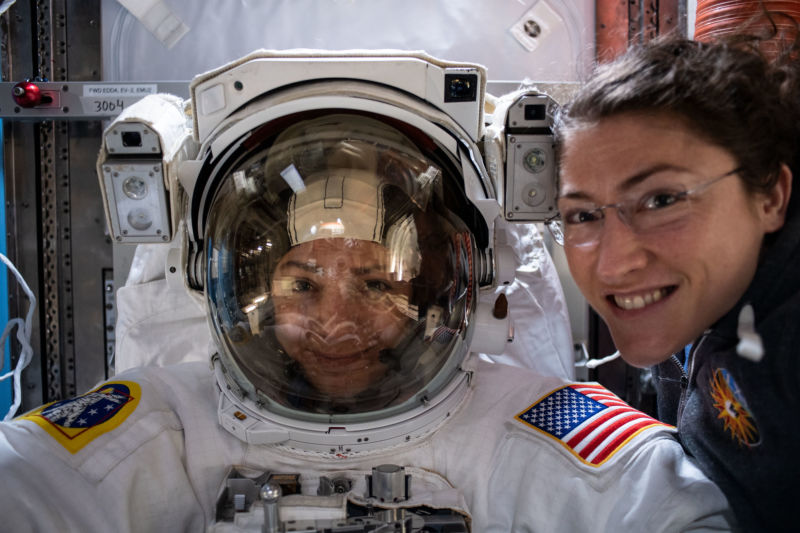
NASA
Almost exactly two years ago, as it prepared for the next generation of human spaceflight, NASA chose a pair of private companies to design and develop new spacesuits. These were to be new spacesuits that would allow astronauts to both perform spacewalks outside the International Space Station as well as walk on the Moon as part of the Artemis program.
Now, that plan appears to be in trouble, with one of the spacesuit providers—Collins Aerospace—expected to back out, Ars has learned. It’s a blow for NASA, because the space agency really needs modern spacesuits.
NASA’s Apollo-era suits have long been retired. The current suits used for spacewalks in low-Earth orbit are four decades old. “These new capabilities will allow us to continue on the ISS and allows us to do the Artemis program and continue on to Mars,” said the director of Johnson Space Center, Vanessa Wyche, during a celebratory news conference in Houston two years ago.
The two winning teams were led by Collins Aerospace and Axiom Space, respectively. They were eligible for task orders worth up to $3.5 billion—in essence NASA would rent the use of these suits for a couple of decades. Since then, NASA has designated Axiom to work primarily on a suit for the Moon and the Artemis Program, and Collins with developing a suit for operations in-orbit, such as space station servicing.
Collins exits
This week, however, Collins said it will likely end its participation in the Exploration Extravehicular Activity Services, or xEVAS, contract. On Tuesday morning Chris Ayers, general manager at Collins Aerospace, met with employees to tell them about the company’s exit from the program. A NASA source confirmed decision.
“Unfortunately Collins has been significantly behind schedule,” a person familiar with the situation told Ars. “Collins has admitted they have drastically underperformed and have overspent on their xEVAS work, culminating in a request to be taken off the contract or renegotiate the scope and their budget.”
NASA and Collins Aerospace acknowledged a request for comment sent by Ars early on Tuesday morning but, as of the afternoon, did not provide substantive replies to questions about this action, nor steps forward.
The agency has been experiencing periodic problems with the maintenance of the suits built decades ago, known as the Extravehicular Mobility Unit, which made its debut in the 1980s. NASA has acknowledged the suit has exceeded its planned design lifetime. Just this Monday, the agency had to halt a spacewalk after the airlock had been de-pressurized and the hatch opened due to a water leak in the service and cooling umbilical unit of Tracy Dyson’s spacesuit.
As a result of this problem, NASA will likely only be able to conduct a single spacewalk this summer, after initially planning three, to complete work outside the International Space Station.
Increased pressure on Axiom
During the bidding process for the commercial spacesuit program, which unfolded in 2021 and 2022, just two bidders ultimately emerged. A unit of Raytheon Technologies, Collins was the bidder with the most experience in spacesuits, having designed the original Apollo suits, and it partnered with experienced providers ILC Dover and Oceaneering. Axiom is a newer company that, until the spacesuit competition, was largely focused on developing a private space station.
As they evaluated bids, NASA officials raised some concerns about Collins’ approach, noting that the proposal relied on “rapid acceleration of technology maturation and resolution of key technical trade studies to achieve their proposed schedule.” However, in its source selection statement, the agency concluded that it had a “high level of confidence” that Collins would be able to deliver on its spacesuits.
It is unclear what NASA will do now. One person suggested that NASA would not seek to immediately re-compete the xEVAS because it could signal to private investors that Axiom is not capable of delivering on its spacesuit contracts. (Like a lot of other companies in this capital-constrained era, Axiom Space, according to sources, has been struggling to raise a steady stream of private investment.)
Another source, however, suggested that NASA likely would seek to bring a new partner on board to compete with Axiom. The space agency did something similar in 2007 with its Commercial Orbital Transportation Services program to provide cargo to the space station. When Rocketplane Kistler could not deliver on its commitments, the agency recompeted the contract and ultimately selected Orbital Sciences. If NASA were to re-open competition, one of the bidders could be SpaceX, which has already designed a basic spacesuit to support the private Polaris Dawn mission.
Since the awards two years ago, Axiom has been making comparatively better technical progress on its spacesuit, which is based on the Extravehicular Mobility Unit design that NASA has used for decades. However, the Houston-based company has yet to complete the critical design review process, which can be demanding. Axiom is also battling a difficult supply chain environment—which is especially problematic given that NASA has not built new suits for such a long time.
